Diagnostic Parasitology for Veterinary Technicians, 6th Edition

Gain the knowledge you need to Identify and understand animal parasites! Diagnostic Parasitology for Veterinary Technicians, 6th Edition features clear and concise discussions of the most commonly encountered internal and external parasites. Chapters are organized by parasite group — including nematodes, cestodes, trematodes, protozoans, arthropods, and leeches — and include a detailed description of the group, with special emphasis on morphology, life cycle, and important parasites. Then in each chapter, material is conveniently organized by host species: dogs, cats, horses, ruminants, swine, birds, lab animals, fish, and reptiles. Written by educators Charles M. Hendrix and Ed Robinson, this full-color, spiral-bound book provides the skills that veterinary technicians need to collect samples, perform lab procedures, and communicate with clients.
Autor: Charles M. Hendrix, DVM, PhD and Ed Robinson, CVT
| Nakladatel | Elsevier Saunders |
|---|---|
| ISBN | 9780323831031 |
| Vydání | VI. vydání 2022 |
| Vazba | brožovaná |
| Počet stran | 388 |
New to this edition
NEW! Thorough updates are included throughout the book, providing the most current coverage of the parasites most often seen in veterinary practice.
NEW! New information on hookworm and heartworm resistance is added to this edition.
NEW! How to Talk to Clients boxes prepare you to answer vital customer questions regarding the most common zoonotic diseases, including scabies, hookworm, heartworm, toxoplasmosis, and more.
Key Features
More than 300 full-color photos help you learn to recognize parasites and parasitic diseases in lab samples.
Logical organization of chapters begins with an overview of external parasites, internal parasites, and nematodes, followed by chapters that go into detail of the parasites by host species.
Step-by-step guidelines are provided for gathering samples and performing lab procedures, with clear instructions about how to perform the different laboratory techniques used in identifying parasites.
Emphasis on life cycles along with high-quality life cycle drawings help you learn to communicate prevention and control strategies to clients.
Case studies provide the opportunity to apply what you have learned.
Review tools ensure that you master parasitology with all-new multiple-choice questions and VTNE prep questions, as well as matching exercises and questions for thought and discussion at the end of each chapter.
Technician’s Note boxes call out important points for vet techs to remember.
Coverage of exotics includes detailed images and discussions of the parasites that affect them.
Parasites by Host Species tables summarize the many ways of categorizing parasites, cross referencing such categories as body systems affected, taxonomic grouping, host species, and location in host.
Author Information
By Charles M. Hendrix, DVM, PhD, Professor of Parasitology, Department of Pathobiology, College of Veterinary Medicine, Auburn University, Auburn, AL and Ed Robinson, CVT
1. The Language of Veterinary Parasitology
2. Parasites That Infect and Infest Domestic
3. Introduction to the Nematodes
4. Nematodes That Infect Domestic Animals
5. The Phylum Platyhelminthes, Class Cestoda
6. Tapeworms That Parasitize Domestic Animals and Humans
7. The Phylum Platyhelminthes, Class Trematoda
8. Trematodes (Flukes) of Animals and Humans
9. The Phylum Acanthocephala
10. The Protozoans
11. Common Protozoans That Infect Domestic Animals
12. Introduction to the Arthropods
13. Arthropods That Infect and Infest Domestic Animals
14. Introduction to the Phylum Arthropoda, Subphylum Pentastomida
15. The Phylum Annelida
16. Parasites of Public Health Importance in Veterinary Parasitology
17. Common Laboratory Procedures for Diagnosing Parasitism
18. Reference to Common Parasite Ova and Forms Seen in Veterinary Medicine
Epilogue: Becoming Proficient in Veterinary Medicine’s Most Important Skill
Appendix A: Parasite Reference List by Species and Parasite Type
Appendix B: VTNE Review Questions in Parasitology
Appendix C: Antiparasitic Drugs by Host Species
Appendix D: Zoonotic and Discourse—Speaking or Writing Authoritatively
Glossary
Index